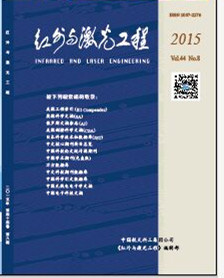Ma Tianlei, Shi Zelin, Yin Jian, Xu Baoshu, Liu Yunpeng. Dim air target detection based on radiation accumulation and space inversion[J]. Infrared and Laser Engineering, 2015, 44(11): 3500-3506.
| Citation:
|
Ma Tianlei, Shi Zelin, Yin Jian, Xu Baoshu, Liu Yunpeng. Dim air target detection based on radiation accumulation and space inversion[J]. Infrared and Laser Engineering, 2015, 44(11): 3500-3506.
|
Dim air target detection based on radiation accumulation and space inversion
- 1.
Shenyang Institute of Automation,Chinese Academy of Sciences,Shenyang 110016,China;
- 2.
Key Laboratory of Optical-Electronics Information Processing,Chinese Academy of Sciences,Shenyang 110016,China;
- 3.
University of Chinese Academy of Sciences,Beijing 100049,China;
- 4.
The Research Institute on General Development and Argumentation of Equipment of Air Force,Beijing 100076,China
- Received Date: 2015-03-05
- Rev Recd Date:
2015-04-03
- Publish Date:
2015-11-25
-
Abstract
Background radiation noise interference is a difficult technical problem for dim signal detection. A dim target detection algorithm was proposed which can significantly improve signal-to-noise ratio(SNR) to achieve uniformly motion dim target detection successfully. Firstly, a coordinate space and a velocity space were established. Then the original image sequence was stacked along different velocity vectors to acquire a new image sequence with SNR improved and the new image sequence forms an image space. Secondly, quasi-target points in the image space were detected by constant false-alarm ratio(CFAR) judging. Finally, velocity vectors and coordinate vectors of quasi-target points were mapped to the velocity space and the coordinate space respectively. As a result, two local peaks from the spaces will confirm true target points.Experiments of real images from actual IR imaging system show that proposed algorithm can improve SNR approximately up to N times of original image SNR, and the proposed algorithm is demonstrably superior to compared algorithms on detection probability and false alarm probability.
-
References
|
[1]
|
Bai Xiangzhi, Zhou Fugen. Analysis of new top-hat transformation and the application for infrared dimsmall target detection[J]. Pattern Recognition, 2010, 43: 2145-2156. |
|
[2]
|
Chen Fei. Research on dim point target detection and tracking in low SNR infrared image sequences[D]. Shanghai: Shanghai Jiao Tong University, 2003. (in Chinese) |
|
[3]
|
Kim Sungho, Yang Yukyung, Lee Joohyoung, et al. Small target detection utilizing robust methods of the human visual system for IRST[J]. Journal of Infrared Millimeter and Terahertz Waves, 2009, 30: 994-1011. |
|
[4]
|
Philip Chen C L, Li Hong, Wei Yantao, et al. A local contrast method for small infrared target detection[J]. IEEE Transactions on Geoscience and Remote Sensing, 2014, 51(1): 574-581. |
|
[5]
|
Johnston L A, Krishnamurthy V. Performance analysis of a dynamic programming track before detect algorithm[J]. IEEE Transactions on Aerospace and Electronic Systems, 2002, 38(1): 228-242. |
|
[6]
|
Huang Linmei, Zhang Guilin, Wang Xinyu. Detecting of small infrared moving object based on dynamic programming algorithm[J]. Infrared and Laser Engineering, 2004, 33(3): 303-306. (in Chinese) |
|
[7]
|
Zhang Fei, Li Chengfang, Shi Lina. Detecting and tracking dim moving point target in IR image sequence[J]. Infrared Physics Technology, 2005, 46: 323-328. |
|
[8]
|
Zhang Qiang, Cai Jingju, Zhang Qiheng. Dim-small moving target detection in infrared image sequences[J]. High Power Laser and Particle Beams, 2011, 23(12): 3312-3316. (in Chinese) |
|
[9]
|
Nicola Acito, Alessandro Rossi, Marco Diani, et al. Optimal criterion to select the background estimation algorithm for detection of dim point targets in infrared surveillance systems[J]. Optical Engineering, 2011, 50(10): 107204: 1-12. |
|
[10]
|
Xue Yonghong, Rao Peng, Fan Shiwei, et al. Infrared dim small target detection algorithm based on generative Markov random field and local statistic characteristic[J]. Journal of Infrared and Millimeter Waves, 2013, 32(5): 431-436. (in Chinese) |
|
[11]
|
Shao Xiaopeng, Fan Hua, Lu Guangxu, et al. An improved infrared dim and small target detection algorithm based on the contrast mechanism of human visual system[J]. Infrared Physics Technology, 2012, 55: 403-408. |
-
-
Proportional views

-









 DownLoad:
DownLoad: